2. 中国地震台网中心, 北京 100045;
3. 中国地震局地球物理研究所, 北京 100081;
4. 中国科学技术大学蒙城地球物理国家野外科学观测研究站, 合肥 230026
2. China Earthquake Networks Center, Beijing 100045, China;
3. Institute of Geophysics, China Earthquake Administration, Beijing 100081, China;
4. Mengcheng National Geophysical Observatory, University of Science and Technology of China, Hefei 230026, China
地震的震源深度是地震学研究的关键参数之一,准确的震源深度对于地壳应力与流变学性质、孕震机理、发震构造、灾害评估等研究均具有重要意义(丁志峰和曾融生,1990;高原等,1997;Maggi et al., 2000; Zhang et al., 2002;石耀霖和朱守彪,2003;吴建平等,2004;周仕勇等,2006;陈九辉等,2009; 孙茁等,2014; 柳畅等,2014). 例如,一般说来由于大陆地区下地壳温度高,主要处于韧性形变状态,因此地震活动性很低.但是也有研究表明中下地壳内发生了地震(Maggi et al., 2000; 姜明明等,2009; 韦生吉等,2009),其成因已经成为大陆动力学研究的重要内容之一.国际上地震学工作者在全球开展了大陆下地壳地震的寻找及确认工作,发现一些地区确实存在下地壳甚至上地幔地震,并对其成因及与构造关系进行了探讨(Maggi et al., 2000; Chen and Yang, 2004; Huang et al., 2011).不仅如此,在地球内部结构研究方面,地震目录中较大的震源深度误差也会影响到时和波形计算的准确性,进而影响地壳上地幔结构成像结果的可靠性(吴建平等,2009; Li et al., 2012,2014a,2014b,2014c). USGS的地震目录提供了全球范围内4~5级以上地震的震中和震源深度信息,是地震成像、孕震机制等震源深度相关研究重要的数据来源.USGS地震目录显示:1970年以来我国地震南北带存在大量震源深度 大于30 km的地震(图 1),这些地震是否属于下地壳地震、其震源深度是否可靠?对于研究这一区域的孕震机制和构造演化具有积极意义.
 | 图 1(a)南北地震带及邻区1970—2013年间地震及震源深度分布图;(b)1970—2013年间地震的震源深度分布;(c)2000—2013年间地震的震源深度分布 图 1b和c仅统计了图 1a中虚线范围内的地震事件,且震源深度大于50 km的地震统计在40~50 km间的地震数目中.考虑到10和33 km是USGS地震目录中震源深度精度不高时的缺省值,图b和c的10~20 km与30~40 km深度间红色柱状图剔除震源深度为10和33 km地震后的数目;灰色柱状图分别为包含震源深度为10和33 km地震的数目,其顶端的数字分别代表震源深度为10和33 km的地震数目.可以看出,在2000年以来,在南北地震带的USGS地震目录中仍存在大量震源深度大于30 km的地震事件(数据来源:USGS).Fig. 1(a)Distribution of epicenter and focal depth for the earthquakes in the North-South Seismic Belt and its adjacent regions during 1970~2013;(b)Focal depth distribution for the earthquakes in the North-South Seismic Belt during 1970—2013;(c)Focal depth distribution for the earthquakes in the North-South Seismic Belt during 2000—2013. Only the earthquakes inside the dashed lines in Fig. 1a are included in the Fig. 1b and c. The earthquakes with focal depth greater than 50 km are taken as the 40~50 km in Fig. 1b and c. Consider that the focal depth of 10 and 33 km are the default values in the USGS earthquake catalog for low accuracy focal depths,the earthquake with 10 and 33 km focal depth are excluded from the red histograms but included in the gray histograms with the numbers indicatingthe real counts for these earthquakes with focal depths of 10 and 33 km respectively. Based on Fig. 1,a large number of earthquakes with focal depth greater than 30 km are included in the USGS catalog even after the year of 2000.(Earthquake catalog is from USGS). |
鉴于地震震源深度的重要意义,地震学者一直在研究改善震源深度测定精度的方法.基于震相到时数据的地震定位方法是测定震源深度的常用方法,震相到时、尤其是初至P波震相信噪比高,易于识别和拾取,可用数据多,在地震定位中得到广泛应用,并发展出多事件联合定位法、主事件法、双差法等多种方法(Douglas,1967; Spence,1980; 周仕勇等,1999; Waldhauser and Ellsworth, 2000; 杨智娴等,2003;Xu et al., 2006; Li et al., 2013; 陈晨和胥颐,2013; 苏金蓉等,2013; 张广伟和雷建设,2013; 赵博等,2013).一般说来,只有台站方位分布较为均匀且有近台(震中距小于1~2倍震源深度)记录时,基于到时数据的地震定位方法才可获得比较可靠的震源深度(Stein and Wiens, 1986; Mori,1999).然而,在台站方位角覆盖通常不够良好,近台记录也较少时,如何充分利用一两个台站的地震波形数据较为准确地测定震源深度仍然是地震学研究的热点问题之一.
地震波形记录(偏振、振幅、相位、频谱等特征)中存在一些对于震源深度比较敏感的信息.例如,近震和远震事件波形中的深度震相(如sPg、sPn、sPmP、sSmS、sPL、pP、sP等)与对应参考震相的到时差对于震源深度的变化比较敏感,基于少量台站的波形记录即可较为准确测定震源深度(Langston,1987;Mori,1991;房明山等,1995;Zhang et al., 2008;姜明明等,2009;Ma,2010;崇加军等,2010; Wang et al., 2011;韩立波等,2012; 罗艳等,2013;高金哲等,2013; Li et al., 2014b; 孙茁等,2014).Engdahl等(1998)将远震深度震相(pP,pwP,sP等)用于震源深度测定,与ISC(国际地震中心,International Seismological Centre)、USGS地震目录中基于到时的结果相比,震源深度的精度有明显提高.除了深度震相之外,瑞利面波振幅谱、勒夫面波频谱、瑞利面波与体波振幅比对于震源深度也比较敏感,也用于震源深度的测定(Tsai and Aki, 1970; Luo et al., 2010,2011; Fox et al., 2012).在台站方位角分布较好、地壳结构模型较为简单地区,利用多个宽频带地震台的波形反演震源机制解时,也可同时获得中等地震(M4~6)较为准确的震源深度,如目前广泛采用的“裁剪-粘贴”(Cut and Paste,CAP)方法(Zhu and Helmberger, 1996).
在基于地震波形数据测定震源深度的方法中,sPL深度震相和短周期瑞利波(Rg波)方法均使用较近震中距的波形信息(sPL一般发育在70 km以内,短周期Rg波方法则一般使用100 km以内的波形数据),因此即使是震级较小的地震(约M3)一般也有较高信噪比的波形数据可供使用.这两种方法比较简便易行(由于震中距小,PmP等震相尚未发育,不会干扰sPL震相的辨识;短周期Rg波可由径向及垂向分量波形经90度相移分析确定),对于测定中小地震的震源深度具有一定优势.但是这两种方法只在部分地区的地震案例研究中进行了探讨,其适应度及准确度尚需进一步深入研究.
本文选取的研究区为南北地震带,是我国地震活动最为活跃的区域之一,同时也是我国地震学研究的重要区域.近年来南北地震带地震台网密度增加为准确测定中小地震的震源深度提供了有利条件,成为研究和验证基于波形的震源深度测定方法的理想区域.2012年11月间南北地震带发生了5个中等强度地震,分别是宁夏会宁4.6级地震、云南富民4.7级地震、四川会东4.7级地震、四川隆昌4.6级和4.9级地震(表 1和图 2).USGS正式地震目录显示:上述4个地震的震源深度均接近或大于30 km;而在USGS的快速定位目录中,四川会东地震的震源深度更是深达46 km(表 1).同时,虽然USGS地震目录中给出的四川隆昌4.9级地震的震源深度为10 km,但是经过对较近震中距台站记录的地震波形进行分析,发现短周期瑞利面波非常发育,暗示了很浅的震源深度.考虑到上述地震事件中既可能存在很浅的地震,也可能存在很深的地震,有利于分析不同震源深度情况下sPL及短周期Rg波测定震源深度方法的有效性.本文以南北地震带上述5个4~5级地震为例,开展基于sPL深度震相和短周期Rg波等波形方法的震源深度测定工作,并与CAP方法的震源深度测定结果进行了对比分析,从而对南北地震带地区USGS地震目录中4~5级地震震源深度的可靠性进行初步分析.
| 表 1 2012年11月南北地震带5个4~5级地震的震源参数(数据来源:USGS)Table 1 Source parameters for the 5 earthquakes in the North-South Seismic Belt during Nov. 2012(data source: USGS) |
 | 图 2(a)南北地震带5个4~5级地震的震中分布(白色圆点);(b)2012-11-20宁夏会宁4.7级地震;(c)2012-11-09云南富民4.8级地震;(d)2012-11-14四川会东4.7级地震;(e)2012-11-11四川隆昌4.6级和2012-11-104.9级地震的空间分布以及使用CAP方法确定震源机制解所用的台站(灰色圆点为地震震中;三角为台站).Fig. 2(a)Epicenter distribution of M4~5 earthquakes in the North-South Seismic Belt. White circles indicate the epicenter of the earthquakes. The station distributions used in the mechanism determination with the CAP method for(b)M4.7 earthquake in Huining,Ningxia(c)M4.8 earthquake in Fumin,Yunan(d)M4.7 earthquake in Huidong,Sichuan and (e)M4.6 and M4.9 earthquakes in Longchang,Sichuan. Gray circles show the epicenters of the earthquakes and black triangles show the distribution of stations. |
sPL震相是由S波入射到自由地表并在近地表低速层中经过多次转换而形成近水平传播的P波震相,在约2倍震源深度以远的震中距上比较发育,早于S波到达(图 3)(Langston,1987; 崇加军等,2010).由于sPL与P波相对到时差消除了发震时刻的影响,且几乎不随震中距变化,减小了地震水平位置误差的影响,因此具有较高的震源深度测定精度.sPL震相一般出现在较小震中距上(70 km以内),波形数据信噪比较高,可以用于2级左右小地震的震源深度测定(包丰等,2013).同时,在小震中距范围内PmP、Pn震相尚未发育,有助于sPL震相的准确识别.已有研究结果表明:基于近震深度震相sPL与P波的相对到时差可以较为准确地测定地震的震源深度,并在2011年安庆地震、2011年瑞昌地震、2008年攀枝花地震、2008年汶川地震余震等震源深度研究中取得了良好的应用效果(崇加军等,2009;Luo et al., 2010,2011;Wang et al., 2011;谢祖军等,2012;包丰等,2013).
 | 图 3 sPL深度震相与直达P波的射线路径示意图Fig. 3 Ray paths for the sPL depth phase and direct P wave |
短周期Rg波及其与体波(P波和S波)振幅比(Rg/P和Rg/S)也是约束地震震源深度的有效方法之一.短周期Rg波一般在震中距大于5倍震源深度时才比较发育,因此当在台站记录中观测到较强的短周期Rg波时,可以大致判断震源深度应该在1/5震中距以内.对于大陆板块内部地震来说,一般当震源深度较大(如大于10 km)时就不易观测到短周期Rg波,因此强烈的短周期Rg波是判断浅源地震的标识之一(Luo et al., 2010,2011).同时,随震源深度的增加,短周期Rg波的振幅快速减小,而P波和S波振幅则影响不大,即Rg/P和Rg/S振幅比会随震源深度的增加而迅速减小.因此,利用高信噪比的地震波形,利用Rg/P或Rg/S振幅比可以较为准确测定地震的震源深度(Luo et al., 2010,2011).
CAP方法通过利用方位角分布较好的宽频带波形数据,基于网格搜索方法获得波形拟合误差最小的震源机制解和震源深度.由于采用了分别拟合体波(Pnl)和面波波形的方式,因此CAP方法对速度结构和地壳横向不均匀性不敏感,可以比较准确地测定地震的震源深度(Zhu and Helmberger, 1996).在利用CAP方法反演震源深度和sPL深度震相获得震源深度时,采用了的频率-波数(F-K)方法(Zhu and Rivera, 2002)计算理论地震图.该方法通过对频率和波数分别进行积分,采用传播矩阵进行计算.CAP方法已经在2008年汶川地震余震、2010年河南太康地震等震源参数研究中有较多应用,显示出良好的应用效果(Zheng et al., 2009;韦生吉等,2009; Luo et al., 2010;韩立波等,2012;Han et al., 2014).
3 数据分析与结果本文收集了2012年11月间南北地震带区域台网的5次4~5级地震事件的三分量宽频带波形数据(郑秀芬等,2009),包括宁夏会宁4.6级地震、云南富民4.7级地震、四川会东4.7级地震、四川隆昌4.6级和4.9级地震(表 1),按照方位角分布和信噪比等要求挑选出可用的地震波形数据,并完成去除仪器响应、水平分量旋转至径向和切向分量等数据预处理.
3.1 利用CAP方法反演震源机制解和震源深度首先使用CAP方法反演了上述地震的震源机制解和震源深度.对于每个地震,所用到的台站分布分别如图 2(b—e)所示.对Pnl部分的波形数据采 用0.02~0.15 Hz的带通滤波,面波部分使用0.01~0.12 Hz 的带通滤波,并对合成地震图的波形采用相同的滤波处理.为了平衡Pnl和面波数据的权重,波形拟合中二者的权重设为2 ∶ 1.地壳速度模型参考了CRUST2.0模型,并根据赵珠等(1997)、杨智娴等(2003)、吴建平等(2004,2009)的研究结果对模型进行了部分修改.通过网格搜索方法在全参数空间范围内进行搜索,分别获得了5个地震的最佳震源机制解、震源深度和矩震级(图 4).可以看出,大部分台站的合成地震图可以较好地拟合观测地震波形.波形拟合误差和震源机制解随震源深度的变化如图 5所示.基于CAP方法的震源深度测定结果表明:宁夏会宁4.6级地震、云南富民4.7级地震、四川会东4.7级地震的震源深度分别为10、13 km和8 km.四川隆昌4.6级和4.9级地震的震源深度均为4 km(表 2).
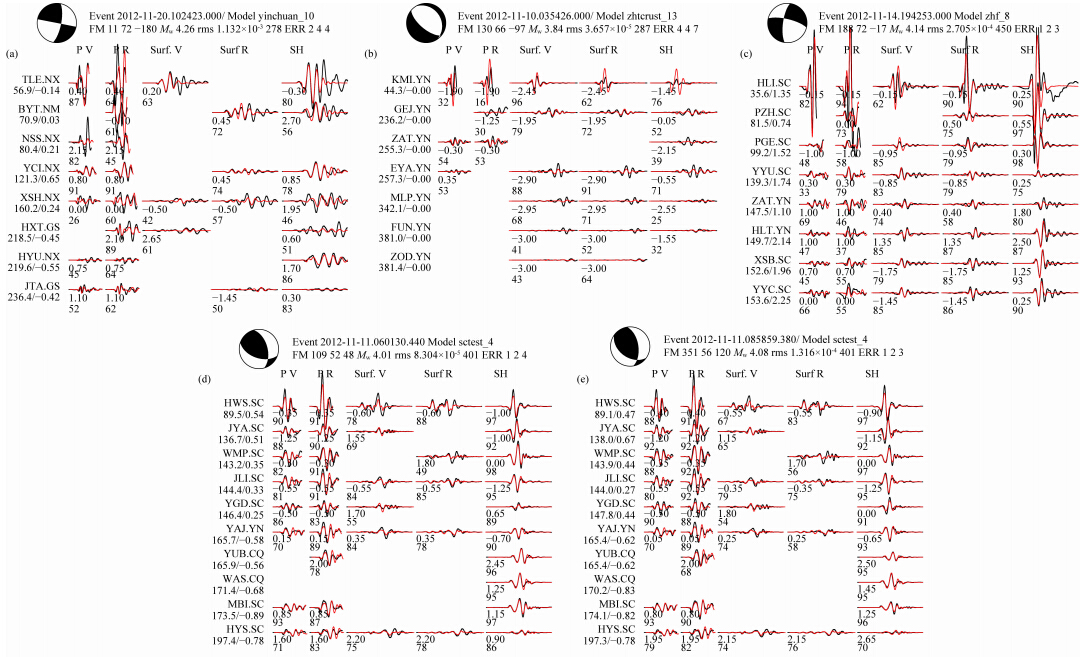 | 图 4 基于CAP方法的震源机制解反演结果 (a)宁夏会宁4.7级地震;(b)云南富民4.8级地震;(c)四川会东地震4.7级地震;(d)四川隆昌4.6级地震;(e)四川隆昌4.9级地震。理论波形为黑色,波形体下方第一行数字为理论波形相对于观测波形的移动时间,单位为秒,正值为超前。第二行数字为理论波形与观测波形的相关系数百分比,波形左侧字母为台站名,震中距和整体移动时间标注在其下方。震源球黑色区域为压缩区,白色区域为拉张区,震源球采用下半球投影Fig. 4 The focal mechanism inversion result swith CAP method (a)M4.7 earthquake in Huining,Ningxia;(b)M4.8 earthquake in Fumin,Yunnan;(c)M4.8 earthquake inHuidong,Sichuan;(d)M4.6 earthquake in Longchang;(e)M4.9 earthquake in Longchang,Sichuan.Black lines show the observed waveforms and red lines show the synthetic waveforms. |
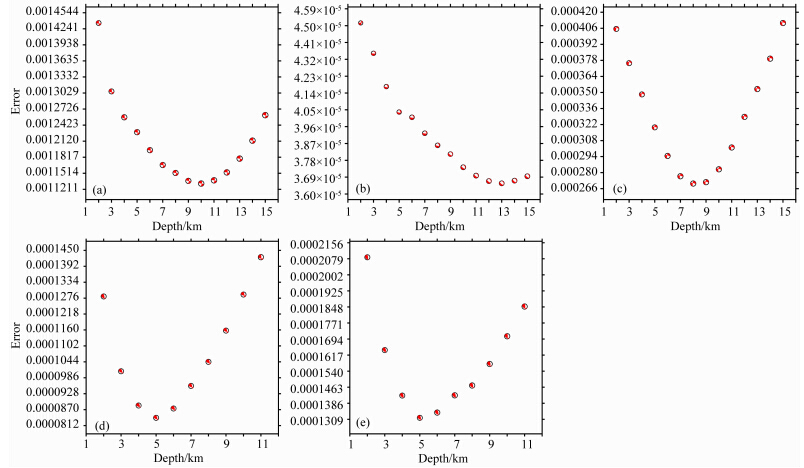 | 图 5 波形拟合误差和震源机制解随地震震源深度的变化情况 (a)宁夏会宁4.7级地震;(b)云南富民4.8级地震;(c)四川会东4.7级地震;(d)和(e)分别为隆昌4.6和4.9级地震.Fig. 5 The waveform misfit variation for the focal mechanisms and the focal depth (a)M4.7 earthquake in Huining,Ningxia(b)M4.8 earthquake in Fumin,Yunan(c)M4.7 earthquake in Huidong,Sichuan and (d)M4.6 and (e)M4.9 earthquakes in Longchang,Sichuan. |
| 表 2 不同方法和机构给出的震源深度结果Table 2 Focal depth results from CAP、sPL and short-period Rg methods and USGS and CENC catalogs |
鉴于sPL震相多出现在数十千米震中距的台站上,对震中距20~70 km范围内台站的三分量位移波形进行了分析,挑选出高信噪比波形记录,将水平分量波形旋转至径向和切向,使初至P波波形在切向分量能量最小,并进行滤波处理,根据P波震相特征挑选出具有清晰sPL震相的波形用于震源深度分析.对于宁夏会宁地震(YCH台)、云南富民地震(KMI台)、四川会东地震(HLI台)的位移波形记录,采用0.1~1 Hz的带通滤波;对于隆昌4.6级和4.9级地震(ROC台),采用0.1~5 Hz的带通滤波.图 6分别给出了上述5个地震处理后的三分量位移波形,可以看出,在径向和垂向分量上sPL震相特征比较明显,而在切向分量上不明显,符合sPL震相为S波在地表全反射为P波的特征.利用CAP方法反演的震源机制解参数,使用FK方法计算了合成地震图并对sPL震相进行了拟合对比.对于宁夏会宁地震、云南富民地震、四川会东地震,采用了与使用CAP方法反演震源机制解时相同的速度模型;对于隆昌4.6级和4.9级地震,由于震源区和分析sPL震相的ROC台均位于具有较厚沉积层地区,因此采用了万柯松等(2010)基于有限频率波形反演得到的一维速度模型.这一模型较好地反映了沉积层的影响,在四川遂宁地区极浅源地震深度测定的研究中显示出良好的应用效果(Luo et al., 2011).
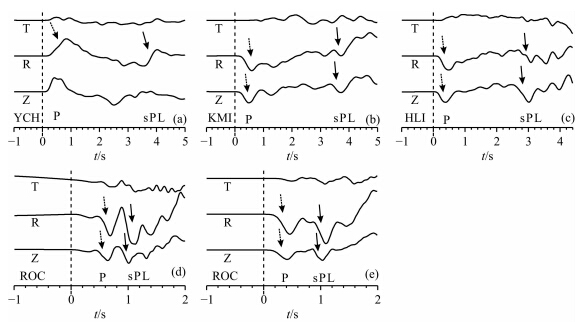 | 图 6 地震三分量位移波形中的sPL深度震相 (a)宁夏会宁地震;(b)云南富民地震;(c)四川会东地震;(d)和(e)分别为隆昌4.6和4.9级地震.虚线标出了初至P波震相到时,箭头分别标出了P波和sPL震相的位置,图左下角给出了波形记录的台站名.(a—c)中的波形采用了0.1~1 Hz的带通滤波,(d—e)的波形采用了0.1~5 Hz的带通滤波.Fig. 6 The sPL phases in three component seismic waveforms (a)Huining eartqhauke in Ningxia Province;(b)Fumin eartqhauke in Yunnan Province;(c)Huidong eartqhauke in Sichuan Province;(d)M4.6 Longchan earthquake in Sichuan Province;(e)M4.9 Longchan earthquake in Sichuan Province. The dashed lines show the arrival times of first P phase. The arrows show the position of sPL phases. The station name is labeled on the lower left of each figure. A 0.1~1 Hz b and pass filters are used for(a—c) and 0.1~5 Hz b and pass filters are used for(d—e). |
图 7对比了宁夏会宁地震(YCH台)、云南富民地震(KMI台)、四川会东地震(HLI台)、隆昌4.6级和4.9级地震(ROC台)的sPL观测波形与不同震源深度情况下的合成地震图.考虑到震源机制反演结果也存在一定误差,为了拟合初至P波的波形,在计算云南富民地震的合成地震图时将CAP方法得到的滑动角减小了17°,从而使初至P波拟合得更好.结果显示:sPL震相与初至P波的到时差随着震源深度的增大而快速增大,表明sPL震相对于震源深度的敏感性.宁夏会宁地震(YCH台)、云南富民地震(KMI台)、四川会东地震(HLI台)的sPL震相与初至P波到时差在2.5~3.5 s之间变化,而隆昌4.6级和4.9级地震(ROC台)的sPL震相与P波到时差约为0.5 s左右.通过合成地震图的对比,测定了上述地震的震源深度(表 2).宁夏会宁地震的震源深度为10~11 km,云南富民地震的震源深度为11~12 km,四川会东地震的震源深度为8~9 km.隆昌4.6级和4.9级地震的震源深度应该为1~2 km.
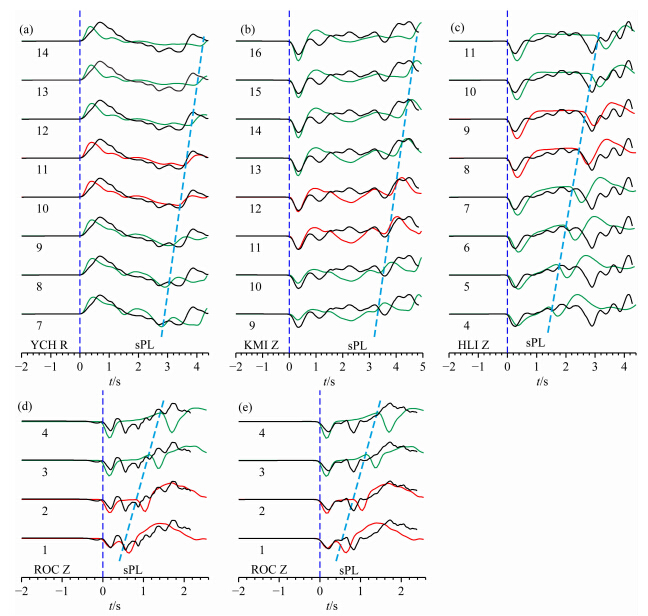 | 图 7 观测与理论sPL震相的波形拟合对比 (a)宁夏会宁地震;(b)云南富民地震;(c)四川会东地震;(d)和(e)分别为隆昌4.6和4.9级地震;蓝色虚线分别标出了sPL的观测和理论到时,其交叉点给出了可能的震源深度.黑色线条为观测波形,红色线条为sPL震相到时拟合较好的合成地震图,绿色线条为sPL拟合较差的合成地震图. 每个图的左上角给出了波形记录的台站名和分量.(a—c)中的波形采用了0.1~1 Hz的带通滤波,(d—e)的波形采用了0.1~5 Hz的带通滤波.波形左侧下方的数字给出了合成地震图计算所用的震源深度.Fig. 7 The comparison of observed(black line) and synthetic(red line)sPL waveforms (a)Huining eartqhauke in Ningxia Province;(b)Fumin eartqhauke in Yunnan Province;(c)Huidong eartqhauke in Sichuan Province;(d)M4.6 Longchan earthquake in Sichuan Province;(e)M4.9 Longchan earthquake in Sichuan Province. The dashed lines show the arrivals of sPL phases. The black lines are the observed waveforms. The red lines are the synthetic waveforms with good fitness for the sPL phases,while the green lines are the synthetic waveforms with worse fitness for the sPL phases. The cross-over shows the possible focal depth. The station name and waveform component are labeled on the lower left of each figure. A 0.1~1 Hz b and pass filters are used for(a—c) and 0.1~5 Hz b and pass filters are used for(d—e). The number on the lower-left of each waveform shows the focal depth used in the synthetic waveform calculations. |
通过分析三分量的位移波形数据,挑选出具有明显短周期Rg波特征的数据进行深入分析.由于短周期Rg波在径向和垂向分量波形存在90°的相位差,对径向分量的位移波形进行Hilbert变换,并与垂向分量波形进行对比,确认短周期Rg波信号.对于不同的震中距和波形数据情况,采用不同的滤波参数以突出短周期Rg波信号.宁夏会宁地震(ZHW台,震中距约131 km)和四川会东地震(YYU台,震中距约121 km)的波形采用了0.05~0.25 Hz的带通滤波;云南富民地震(KMI台,震中距约46 km)的波形采用了0.05~0.3 Hz的带通滤波;四川隆昌4.6级和4.9级地震(ROC台,震中距约30 km)的波形采用了0.2~1 Hz的带通滤波.图 8分别给出了上述地震的短周期Rg波波形数据.可以看出,径向分量经Hilbert变换后,与垂向分量具有良好的一致性,可以确认短周期Rg波.考虑到对于大陆地震来说,一般在5倍震源深度以外、且震源深度较浅时(例如小于10 km)短周期Rg波才比较发育(Luo et al., 2011),因此根据震中距可以推测 上述地震的真实震源深度不会达到USGS地震目 录给出的30 km或更深.而对于云南富民地震和四川隆昌地震,其震中距分别为46 km和30 km,因此其震源深度应该均小于10 km,与USGS地震目录中的结果也存在较大偏差.
 | 图 8(a)宁夏会宁地震;(b)云南富民地震;(c)四川会东地震;(d)隆昌4.6和(e)4.9级地震的垂直与径向分量波形记录可以看出短周期Rg波非常明显.黑色线条为垂直分量,红色线条为径向分量.经过Hilbert变换即90度相移后,R分量与Z分量的面波波形一致,确认为短周期Rg波.(a,c)中的波形采用了0.05~0.25 Hz的带通滤波;(b)中的波形采用了0.05~0.3 Hz的带通滤波;(d—e)的波形采用了0.2~1 Hz的带通滤波.Fig. 8 The vertical(black line) and radial(red line)waveforms for(a)Huining eartqhauke in Ningxia Province;(b)Fumin eartqhauke in Yunnan Province;(c)Huidong eartqhauke in Sichuan Province,Longchang M4.6;(d) and M4.9(e)earthquakes After the Hilbert transform,the vertical and radial waveforms are consistent with each other,so the short period surface wave is confirmed. A 0.05~0.25 Hz b and pass filter is used for(a) and (c); a 0.05~0.3 Hz b and pass filter isused for(b); a 0.2~1 Hz b and pass filter is used for(d) and (e). |
四川隆昌4.6级和4.9级地震在ROC台具有高信噪比的P波波形数据,因此使用Rg/P振幅比测定了这两个地震的震源深度.如图 9所示,在观测波形和合成地震图的Rg波振幅一致的情况下,合成地震图上P波振幅随着震源深度的增加而迅速增加.当震源深度为1 km时,合成地震图要明显大于观测波形上的Rg/P振幅比;而震源深度为3 km时,合成地震图则要明显小于观测波形上的Rg/P振幅比.在震源深度为2 km时,二者比较一致,表明四川隆昌4.6级和4.9级地震的震源深度均为2 km左右.
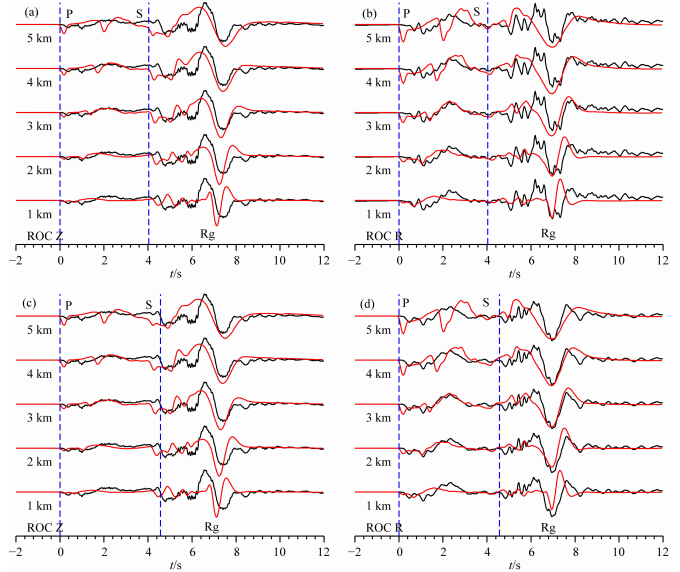 | 图 9 四川隆昌4.6级(a,b)和4.9级(c,d)地震在ROC台的地震观测波形与合成图 (a,c)为垂向分量,(b,d)为径向分量.红色线条为合成地震图,黑色线条为观测波形,均经过0.1~4 Hz的带通滤波.波形左侧下方的数字给出了合成地震图计算所用的震源深度.可以看出,观测与合成地震图的Rg/P振幅比在震源深度为1~2 km时较为一致,表明地震的震源深度在1~2 km左右.Fig. 9 The observed and synthetic waveforms of(a,b)M4.6 and (c,d)M4.9 Longchan earthquake in Sichuan Province (a,c)are the vertical components and (b,d)are the radial components. Red lines show the synthetic waveforms,while black lines show the observed waveforms. The number on the lower-left of each waveform shows the focal depth used in the synthetic waveform calculations. A b and pass filtered of 0.1~4 Hz is used for all waveforms. The amplitude ratios of Rg/P for observed and synthetic waveforms are close when focal depth is 1~2 km. |
本文使用sPL深度震相、短周期Rg波和基于CAP的震源机制解反演方法,测定了2011年11月期间南北地震带5次4~5级地震的震源深度.基于sPL和短周期Rg波的结果显示:宁夏会宁地震的震源深度约为10~11 km,云南富民地震的震源深度约为11~12 km,四川会东地震的震源深度约为8~9 km,四川隆昌两次地震的震源深度均为1~2 km(表 2).对于宁夏会宁、云南富民和四川会东地震,sPL方法与CAP方法结果的差别约为1~2 km.对于属于极浅源的四川隆昌4.6级和4.9级地震的震源深度,sPL方法给出的结果为1~2 km,CAP方法给出的结果为4 km.鉴于这两次地震的短周期Rg波很强,P波震相的信噪比也很高,Rg/P波振幅比的独立研究表明震源深度约为2 km,与sPL的结果一致.两种基于单台波形记录的独立方 法与CAP方法的结果存在2~3 km偏差,这可能是因为CAP方法使用了能够反映较大区域平均速度的一维模型.对于震源深度为1~2 km的极浅源地震,由于震源区存在较大厚度的沉积层等显著速度异常,采用区域尺度的一维模型时,可能会影响CAP方法测定震源深度的精度(孟庆君等,2013).因此,对于极浅源地震,需要利用近台sPL深度震相、Rg/P波振幅比等方法进一步验证CAP方法结果的准确性.相比之下,sPL方法受速度模型的影响不大,研究表明:10%左右的速度模型偏差,对于真实深度为10 km地震测定结果偏差为1 km左右(崇加军等,2009;Luo et al., 2010),显示出sPL方法的可靠性.
表 2同时给出了USGS和中国地震台网中心(CENC)基于到时地震定位方法给出的震源深度结果.与本文基于CAP、sPL深度震相和短周期Rg波的结果相比,在USGS地震目录中,宁夏会宁地震、云南富民地震和四川会东地震的震源深度均在30 km左右,而USGS的快速定位结果给出的四川会东地震的震源深度达到了46 km,存在显著偏差.根据USGS的地震目录,这些地震均发生在下地壳甚至莫霍面附近,在孕震机制和深部构造方面具有明显不同的含义.对于四川隆昌4.6级和4.9级地震,USGS地震目录的震源深度分别为35 km和10 km,也具有较大误差.与USGS地震目录的震源深度结果相比,CENC的结果具有更好的精度,但仍存在一定偏差.尽管基于到时方法和波形方法得到的震源深度在物理含义存在一定差异,即对于到时方法,测定的震源深度主要反映了地震初始破裂点的深度;而对于波形数据,测定的震源深度主要反映了地震破裂的质心深度.但对于4~5级的中小地震来说,破裂尺度一般在千米量级,基于到时和波形测定的震源深度差别不大.因此,USGS和CENC的震源深度存在较大偏差可能是由于缺乏近台等原因造成到时方法难以准确测定地震的震源深度.综上所述,鉴于在南北地震带地区,USGS地震目录中4~5级地震的震源深度可能存在一定误差,因此在使用USGS地震目录数据对这一地区进行地壳应力、孕震机理和发震构造等震源深度相关研究时需考虑误差的影响.当然,本文的工作主要集中在南北地震带地区,仅选取了2012年11月间的5个4~5级地震,还难以全面评价USGS在南北地震带乃至全球的中小地震震源深度的可靠性,相关工作尚需进一步深入系统的研究.
5 结论当地震近台波形记录较少时,如何利用一两个台站的波形数据较为准确地测定中小地震的震源深度,对于地震学的多个研究领域具有重要意义.本文选取地震活动比较活跃、台网较为密集的南北地震带为研究区域,开展了基于sPL深度震相和短周期Rg波的震源深度研究.选取2012年11月南北地震带的5个M4+地震为例,利用基于单台的sPL深度震相方法和短周期Rg波方法独立测定了震源深度,并与CAP方法反演的地震震源深度进行对比分析.结果表明:基于一两个近台的波形记录,使用sPL深度震相和短周期Rg波方法即可较为准确地测定地震的震源深度,方法比较可靠.
震源深度的测定结果显示:2012年11月南北地震带的宁夏会宁4.7级、云南富民4.8级和四川会东4.7级地震的震源深度约为8~12 km,并不是USGS地震目录中所显示的接近或大于30 km 的下地壳地震,仍发生于上地壳.而四川隆昌4.6和4.9级地震则属于震源深度为1~2 km的极浅源地震,与USGS给出的10 km和35 km的震源深度结果相比有明显改进.因此,对于南北地震带地区的4~5级中小地震,USGS地震目录给出的震源深度可能存在较大误差.由于本文仅对少数几个中小地震的震源深度进行了测定,尚需对更多地震深入系统的研究才能全面评估南北地震带地区USGS地震目录中中小地震的震源深度可靠性.
致谢 中国地震局地球物理研究所“国家数字测震台网数据备份中心”为本研究提供了部分地震波形数据,中国地震台网中心和USGS提供了地震目录数据,在此深表谢意.感谢倪四道教授对本文的热情指导和帮助.感谢审稿专家宝贵的修改意见和建议.| [1] | Bao F, Ni S D, Zhao J H, et al. 2013. Accurate earthquake location with instrumental clock error:A case study for the 19 January 2011 Anqing earthquake sequence. Acta Seismologica Sinica (in Chinese), 35(2):160-172. |
| [2] | Chen C, Xu Y. 2013. Relocation of the Lushan Ms7.0 earthquake sequence and its tectonic implications. Chinese J. Geophys. (in Chinese), 56(12):4028-4036, doi:10.6038/cjg20131208. |
| [3] | Chen J H, Liu Q Y, Li S C, et al. 2009. Seismotectonic study by relocation of the Wenchuan Ms8.0 earthquake sequence. Chinese J. Geophys. (in Chinese), 52(2):390-397. |
| [4] | Chen W P, Yang Z H. 2004. Earthquakes beneath the himalayas and tibet:Evidence for strong lithospheric mantle. Science, 304(5679):1949-1952. |
| [5] | Chong J J, Ni S D, Zeng X F. 2010. sPL, an effective seismic phase for determining focal depth at near distance. Chinese J. Geophys. (in Chinese), 53(11):2620-2630, doi:10.3969/j.issn.0001-5733.2010.11.010. |
| [6] | Ding Z F, Zeng R S. 1990. A preliminary study of focal depth distribution in the Beijing-Tianjin-Tangshan area. Acta Seismologica Sinica (in Chinese), 12(3):242-247. |
| [7] | Douglas A. 1967. Joint epicenter determination. Nature, 215(5096):47-48. |
| [8] | Engdahl E R, Van Der Hilst R, Buland R. 1998. Global teleseismic earthquake relocation with improved travel times and procedures for depth determination. Bulletin of the Seismological Society of America, 88(3):722-743. |
| [9] | Fang M S, Du A L, Dong X P, et al. 1995. Determination of focal depth with the sPn phase. Seismological and Geomagnetic Observation and Research (in Chinese), 16(5):13-18. |
| [10] | Fox B D, Selby N D, Heyburn R, et al. 2012. Shallow seismic source parameter determination using intermediate-period surface wave amplitude spectra. Geophysical Journal International, 191(2):601-615. |
| [11] | Gao J Z, Li Z W, Bao F, et al. 2013. Resolving focal depth of the 31 March 2006 Jilin Qianan-Qianguo earthquake with multiple datasets and its implication for seismogenesis. Progress in Geophysics (in Chinese), 28(5):2328-2335, doi:10.6038/pg20130515. |
| [12] | Gao Y, Zhou H L, Zheng S H, et al. 1997. Preliminary discussion on implication of determination on source depth of earthquake. Earthquake Research in China (in Chinese), 13(4):321-329. |
| [13] | Han L B, Jiang C S, Bao F. 2012. Source parameter determination of 2010 Taikang Ms4.6 earthquake sequences. Chinese J. Geophys. (in Chinese), 55(9):2973-2981. |
| [14] | Han L B, Zeng X F, Jiang C S, et al. 2014. Focal mechanisms of the 2013 Mw6.6 Lushan, China earthquake and high-resolution aftershock relocations. Seismological Research Letters, 85(1):8-14. |
| [15] | Huang G C D, Roecker S W, Levin V. 2011. Lower-crustal earthquakes in the west Kunlun range. Geophysical Research Letters, 38(1):L01314. |
| [16] | Jiang M M, Zhou S Y, Tong X P, et al. 2009. Accurate depth determination of deep earthquake in southern Tibet and its geodynamic implications. Chinese J. Geophys. (in Chinese), 52(9):2237-2244, doi:10.3969/j.issn.0001-5733.2009.09.007. |
| [17] | Langston C A. 1987. Depth of faulting during the 1968 Meckering, Australia, earthquake sequence determined from waveform analysis of local seismograms. Journal of Geophysical Research, 92(B11):11561-11574. |
| [18] | Li Z W, Ni S D, Hao T Y, et al. 2012. Uppermost mantle structure of the eastern margin of the Tibetan plateau from interstation Pn traveltime difference tomography. Earth and Planetary Science Letters, 335-336:195-205. |
| [19] | Li Z W, Tian B F, Liu S, et al. 2013. Asperity of the 2013 Lushan earthquake in the eastern margin of Tibetan plateau from seismic tomography and aftershock relocation. Geophysical Journal International, 195(3):2016-2022. |
| [20] | Li Z W, Ni S D, Roecker S. 2014a. Interstation Pg and Sg differential traveltime tomography in the northeastern margin of the Tibetan plateau:Implications for spatial extent of crustal flow and segmentation of the Longmenshan fault zone. Physics of the Earth and Planetary Interiors, 227:30-40. |
| [21] | Li Z W, Ni S D, Somerville P. 2014b. Resolving shallow shear-wave velocity structure beneath station CBN by waveform modeling of the Mw5.8 Mineral, Virginia earthquake sequence. Bulletin of the Seismological Society of America, 104(2):944-952. |
| [22] | Li Z W, Roecker S, Kim K, et al. 2014c. Moho depth variations in the Taiwan orogen from joint inversion of seismic arrival time and Bouguer gravity data. Tectonophysics, 632:151-159. |
| [23] | Liu C, Shi Y L, Zhu B J, et al. 2014. Crustal rheology control on the mechanism of the earthquake generation at the Longmen Shan fault. Chinese J. Geophys. (in Chinese), 57(2):404-418, doi:10.6038/cjg20140207. |
| [24] | Luo Y, Ni S D, Zeng X F, et al. 2010. A shallow aftershock sequence in the north-eastern end of the Wenchuan earthquake aftershock zone. Science China Earth Sciences, 53(11):1655-1664. |
| [25] | Luo Y, Ni S D, Zeng X F, et al. 2011. The M5.0 Suining-Tongnan (China) earthquake of 31 January 2010:A destructive earthquake occurring in sedimentary cover. Chinese Science Bulletin, 56(6):521-525. |
| [26] | Luo Y, Zeng X F, Ni S D. 2013. Progress on the determination of focal depth. Progress in Geophysics (in Chinese), 28(5):2309-2321, doi:10.6038/pg20130513. |
| [27] | Ma S. 2010. Focal depth determination for moderate and small earthquakes by modeling regional depth phases sPg, sPmP, and sPn. Bulletin of the Seismological Society of America, 100(3):1073-1088. |
| [28] | Maggi A, Jackson J A, Priestley K, et al. 2000. A re-assessment of focal depth distributions in southern Iran, the Tien Shan and northern India:do earthquakes really occur in the continental mantle? Geophysical Journal International, 143(3):629-661. |
| [29] | Meng Q J. 2013. Research about focal parameters using CAP and depth phases (in Chinese). Hefei:University of Science and Technology of China. |
| [30] | Mori J. 1991. Estimates of velocity structure and source depth using multiple P waves from aftershocks of the 1987 Elmore Ranch and Superstition Hills, California, earthquakes. Bulletin of the Seismological Society of America, 81(2):508-523. |
| [31] | Shi Y L, Zhu S B. 2003. Contrast of rheology in the crust and mantle near Moho revealed by depth variation of earthquake mechanism in continental China. Chinese J. Geophys. (in Chinese), 46(3):350-365. |
| [32] | Spence W. 1980. Relative epicenter determination using P-wave arrival-time differences. Bulletin of the Seismological Society of America, 70(1):171-183. |
| [33] | Stein S, Wiens D A. 1986. Depth determination for shallow teleseismic earthquakes:Methods and results. Review of Geophysics, 24(4):806-832. |
| [34] | Su J R, Zheng Y, Yang J S, et al. 2013. Accurate locating of the Lushan, Sichuan M7.0 earthquake on 20 April 2013 and its aftershocks and analysis of the seismogenic structure. Chinese J. Geophys. (in Chinese), 56(8):2636-2644, doi:10.6038/cig20130813. |
| [35] | Sun Z, Wu J P, Fang L H, et al. 2014. Focal depth determination of aftershocks of Lushan Ms7.0 earthquake from sPn phase. Chinese J. Geophys. (in Chinese), 57(2):430-440, doi:10.6038/cjg20140209. |
| [36] | Tsai Y B, Aki K. 1970. Precise focal depth determination from amplitude spectra of surface waves. Journal of Geophysical Research, 75(29):5729-5744. |
| [37] | Waldhauser F, Ellsworth W. 2000. A double-difference earthquake location algorithm:method and application to the northern Hayward Fault, California. Bulletin of the Seismological Society of America, 90(6):1353-1368. |
| [38] | Wan K S, Ni S D, Zhao L. 2010. Finite frequency waveform inversion for velocity structure in Longmenshan area. Recent Developments in World Seismology (in Chinese), (6):16. |
| [39] | Wang Z J. Chong J J, Ni S D, et al. 2011. Determination of focal depth by two waveformbased methods:A case study for the 2008 Panzhihua |
| [1] | Wei S J, Ni S D, Chong J J, et al. 2009. The 16 August 2003 Chifeng earthquake:Is it a lower crust earthquake? Chinese J. Geophys. (in Chinese), 52(1):111-119. |
| [2] | Wu J P, Ming Y H, Wang C Y. 2004. Source mechanism of small-to-moderate earthquakes and tectonic stress field in Yunnan province. Acta Seismologica Sinica (in Chinese), 26(5):457-465. |
| [3] | Wu J P, Huang Y, Zhang T Z, et al. 2009. Aftershock distribution of the Ms8.0 Wenchuan earthquake and three dimensional P-wave velocity structure in and around source region. Chinese J. Geophys. (in Chinese), 52(2), 320-328. |
| [4] | Xie Z J, Zheng Y, Ni S D, et al. 2012. Focal mechanism and focal depth of the 19 January 2011 Anqing earthquake. Chinese J. Geophys. (in Chinese), 55(5):1624-1634, doi:10.6038/j.issn.0001-5733.2012.05.020. |
| [5] | Xu Y, Roecker S W, Wei R, et al. 2006. Analysis of seismic activity in the crust from earthquake relocation in the central Tien Shan. Bulletin of the Seismological Society of America, 96(2):737-744. |
| [6] | Yang Z X, Chen Y T, Zheng Y J, et al. 2003. Accurate relocation of earthquakes in central-western China using the double-difference earthquake location algorithm. Science in China (Series D), 46(Suppl.):181-188. |
| [7] | Zhang G M, Wang S Y, Li L, et al. 2002. Focal depth research of earthquakes in Mainland China:Implication for tectonics. Chinese Science Bulletin, 47(12):969-974. |
| [8] | Zhang G W, Lei J S. 2013. Relocations of Lushan, Sichuan strong earthquake (Ms7.0) and its aftershocks. Chinese J. Geophys. (in Chinese), 56(5):1764-1771, doi:10.6038/cjg20130534. |
| [9] | Zhang R Q, Wu Q J, Li Y H, et al. 2008. Focal depths for moderate-sized aftershocks of the Wenchuan Ms8.0 earthquake and their implications. Science in China Series D:Earth Sciences, 51(12):1694-1702. |
| [10] | Zhao B, Gao Y, Huang Z B, et al. 2013. Double difference relocation, focal mechanism and stress inversion of Lushan Ms7.0 earthquake sequence. Chinese J. Geophys. (in Chinese), 56(10):3385-3395, doi:10.6038/cjg20140208. |
| [11] | Zhao Z, Fan J, Zheng S H, et al. 1997. Precision determination of the crustal structure and hypocentral locations in the Longmenshan fault zone. Acta Seismologica Sinica (in Chinese), 19(6):615-622. |
| [12] | Zheng X F, Ouyang B, Zhang D N, et al. 2009. Technical system construction of data backup centre for China seismograph network and the data support to researches on the Wenchuan earthquake. Chinese J. Geophys. (in Chinese), 52(5):1412-1417, doi:10.3969/j.issn.0001-5733.2009.05.031. |
| [13] | Zheng, Y, Ma H S, Lü J, et al. 2009. Source mechanism of strong aftershocks (Ms≥5.6) of the 2008/05/12 Wenchuan earthquake and the implication for seismotectonics. Science in China Series D:Earth Sciences, 52(8):739-753. |
| [14] | Zhou S Y, Jiang M M, Robinson R. 2006. The role of fault interactions in the generation of the 1997 Jiashi strong earthquake swarm, Xinjiang, China. Chinese J. Geophys. (in Chinese), 49(4):1102-1109. |
| [15] | Zhou S Y, Xu Z H, Han J. 1999. Analysis on the master event method and precise location of the 1997 Jiashi strong earthquake swarm of western China. Acta Seismologica Sinica (in Chinese), 21(3):258-265. |
| [16] | Zhu L P, Helmberger D V. 1996. Advancement in source estimation techniques using broadband regional seismograms. Bulletin of the Seismological Society of America, 86(5):1634-1641. |
| [17] | Zhu L P, Rivera L A. 2002. A note on the dynamic and static displacements from a point source in multi-layered media. Geophysical Journal International, 148(3):619-627. |
| [40] | 包丰, 倪四道, 赵建和等. 2013. 时钟不准情形地震精确定位研究——以2011年1月19日安庆地震序列为例. 地震学报, 35(2): 160-172. |
| [41] | 陈晨, 胥颐. 2013. 芦山Ms7.0级地震余震序列重新定位及构造意义. 地球物理学报, 56(12): 4028-4036, doi: 10.6038/cjg20131208. |
| [42] | 陈九辉, 刘启元, 李顺成等. 2009. 汶川Ms8.0地震余震序列重新定位及其地震构造研究. 地球物理学报, 52(2): 390-397. |
| [43] | 崇加军, 倪四道, 曾祥方. 2010. sPL, 一个近距离确定震源深度的震相. 地球物理学报, 53(11): 2620-2630, doi: 10.3969/j.issn.0001-5733.2010.11.010. |
| [44] | 丁志峰, 曾融生. 1990. 京津唐地区震源深度分布初探. 地震学报, 12(3): 242-247. |
| [45] | 房明山, 杜安陆, 董孝平等.1995.用sPn震相测定近震震源深度. 地震地磁观测与研究, 16(5):13-18. |
| [46] | 高金哲, 李志伟, 包丰等. 2013. 2006年吉林乾安-前郭M5.0级地震深度研究及其成因探讨. 地球物理学进展, 28(5): 2328-2335, doi: 10.6038/pg20130515. |
| [47] | 高原, 周蕙兰, 郑斯华等. 1997. 测定震源深度的意义的初步讨论. 中国地震, 13(4): 321-329. |
| [48] | 韩立波, 蒋长胜, 包丰. 2012. 2010年河南太康Ms4.6地震序列震源参数的精确确定.地球物理学报, 55(9): 2973-2981. |
| [49] | 姜明明, 周仕勇, 佟啸鹏等. 2009. 藏南地区中深源地震精确定深研究及其地球动力学含义. 地球物理学报, 52(9): 2237-2244, doi: 10.3969/j.issn.0001-5733.2009.09.007. |
| [50] | 柳畅, 石耀霖, 朱伯靖等. 2014. 地壳流变结构控制作用下的龙门山断裂带地震发生机理. 地球物理学报, 57(2): 404-418, doi: 10.6038/cjg20140207. |
| [51] | 罗艳, 曾祥方, 倪四道. 2013. 震源深度测定方法研究进展. 地球物理学进展, 28(5): 2309-2321, doi: 10.6038/pg20130513. |
| [52] | 孟庆君. 2013. CAP方法和深度震相确定地震震源参数研究[硕士论文]. 合肥: 中国科学技术大学地球和空间科学学院. |
| [53] | 石耀霖, 朱守彪. 2003. 中国大陆震源机制深度变化反映的地壳-地幔流变特征. 地球物理学报, 46(3): 395-365. |
| [54] | 苏金蓉, 郑钰, 杨建思等. 2013. 2013年4月20日四川芦山M7.0级地震与余震精确定位及发震构造初探. 地球物理学报, 56(8): 2636-2644, doi: 10.6038/cig20130813. |
| [55] | 孙茁, 吴建平, 房立华等. 2014. 利用sPn震相测定芦山Ms7.0级地震余震的震源深度. 地球物理学报, 57(2): 430-440, doi:10.6038/cjg20140209. |
| [56] | 万柯松, 倪四道, 赵里. 2010. 龙门山周边地区地震波速度结构的有限频率反演. 国际地震动态, (6): 16. |
| [57] | 韦生吉, 倪四道, 崇加军等. 2009. 2003年8月16日赤峰地震: 一个可能发生在下地壳的地震. 地球物理学报, 52(1): 111-119. |
| [58] | 吴建平, 明跃红, 王椿镛. 2004. 云南地区中小地震震源机制及构造应力场研究. 地震学报, 26(5): 457-465. |
| [59] | 吴建平, 黄媛, 张天中等. 2009. 汶川Ms8.0级地震余震分布及周边区域P波三维速度结构研究. 地球物理学报, 52(2): 320-328. |
| [60] | 谢祖军, 郑勇, 倪四道等. 2012. 2011年1月19日安庆ML4.8地震的震源机制解和深度研究. 地球物理学报, 55(5): 1624-1634, doi: 10.6038/j.issn.0001-5733.2012.05.020. |
| [61] | 杨智娴, 陈运泰, 郑月军等2003. 双差地震定位法在我国中西部地区地震精确定位中的应用. 中国科学(D辑), 33(增刊): 129-134. |
| [62] | 张广伟, 雷建设. 2013. 四川芦山7.0级强震及其余震序列重定位. 地球物理学报, 56(5): 1764-1771, doi: 10.6038/cjg20130534. |
| [63] | 赵博, 高原, 黄志斌等. 2013. 四川芦山Ms7.0地震余震序列双差定位、震源机制及应力场反演. 地球物理学报, 56(10): 3385-3395, doi: 10.6038/cjg20140208. |
| [64] | 赵珠, 范军, 郑斯华等. 1997. 龙门山断裂带地壳速度结构和震源位置的精确修定. 地震学报, 19(6): 615-622. |
| [65] | 郑秀芬, 欧阳飚, 张东宁等. 2009. “国家数字测震台网数据备份中心”技术系统建设及其对汶川大地震研究的数据支撑. 地球物理学报, 52(5): 1412-1417 doi: 10.3969/j.issn.0001-5733.2009.05.031. |
| [66] | 周仕勇,许忠淮, 韩京等.1999. 主地震定位方法分析以及1997年新疆伽师震群高精度定位. 地震学报,21(3):258-265. |
| [67] | 周仕勇, 姜明明, Robinson R. 2006. 1997年新疆伽师强震群发展过程中发震断层间相互作用的影响. 地球物理学报, 49(4): 1102-1109. |
 2015, Vol. 58
2015, Vol. 58


